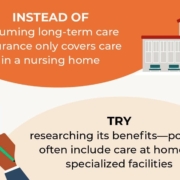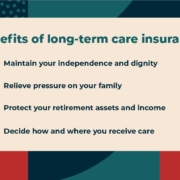Insure or Self-Insure for Long Term Care? – Part 1 – Long Term Care University

Long Term Care University – Question of the Month – 07/15/24
By Aaron Skloff, AIF, CFA, MBA
Q: We are concerned about the exorbitant costs for long term care. Should we insure or self-insure our long term care costs?
The Problem – Paying for Long Term Care
According to the U.S. Department of Health and Human Services, 7 in 10 people over the age of 65 will require long term care. This compares to a 1 in 340 chance of a major auto accident and a 1 in 1,200 chance of a total loss from a fire. About half the people reaching the age of 65 are expected to enter a nursing home at least once in their lifetime.
Click Here for Your Long Term Care Insurance Quotes

Paying for long term care is expensive. The median cost of a private room in a nursing facility is $9,700 per month, an assisted living facility is $5,300 per month and home care is $6,300 per month. If you are 55 years old, expect to pay over two times those amounts when you are likely to need care in 25 years at the age of 80. Based on the average nursing home stay, total costs are expected to reach approximately $921,300 per person.
The Solution – Insure or Self Insure for Your Future Long Term Care Costs
When preparing for your long term care (LTC) costs, you should understand the advantages and disadvantages of insuring versus self-insuring (investing) for your long term care costs. Let’s compare two 55-year-old couples that are of average health and are likely to need care in 25 years at the age of 80. The Millers choose to self-insure (invest) for their long term care costs, while the Smiths choose to insure. Unfortunately, each couple will likely need long term care for five or more years in a combination of locations; including a nursing home, an assisted living facility and their own home. The only saving grace is that their costs may be $11,000 per month per person.
Self-Insure (Invest) for Your Long Term Care Costs. If the Millers invest a combined $8,200 for one year and earn 7% before taxes, they will immediately have a combined $8,200 available for LTC costs. If they invest a combined $200,000 ($8,000 X 25) over 25 years and earn 7% per year before taxes, they will have a combined $541,412 before taxes available for LTC costs, or 2.71 X the investments. Self-insuring (investing) provides a fraction of the leverage insurance provides. See the chart below.
Insure for Your Long Term Care Costs with Traditional Long Term Care Insurance. The Smiths can each purchase a Traditional LTC Insurance policy with inflation protection that would provide an approximate $10,500 monthly benefit per person in 25 years at the age of 80 and a minimum of six years each of LTC. After the Smiths each pay a combined $8,200 for one year, they will have a combined $706,000 tax free available for LTC costs. If they pay a combined $200,000 ($8,000 X 25) over 25 years, they will have a combined $1,592,715 tax free available for LTC costs, or 7.96 X the premiums. Insurance provides a multiple of the leverage self-insuring (investing) provides. See the chart below.
Insure for Your Long Term Care Costs with Hybrid Life and Long Term Care Insurance. The Smiths can each purchase a Hybrid Life and LTC Insurance policy with inflation protection that would provide an approximate $7,300 monthly benefit per person in 25 years at the age of 80 and a minimum of seven years each of LTC. After the Smiths pay a combined $8,000 they will have a combined $705,438 tax free available for LTC costs. In 25 years at the age of 80, they will have a combined $1,319,159 tax free available for LTC costs, or 6.59 X the premiums. They will also have a combined $209,084 tax free death benefit, assuming the policy’s LTC benefits are unused, or 1.05 X the premiums. See the chart below.
Or, the Smiths can purchase a Hybrid Life and LTC Insurance policy without inflation protection that would provide an approximate $6,900 monthly benefit per person in 25 years at the age of 80 and a Lifetime of LTC. After the Smiths pay a combined $8,000, they will have a combined tax free Lifetime (Unlimited) amount available for LTC costs, or unlimited leverage. They also gain a $171,932 tax free death benefit when the second person dies, assuming the policy’s LTC benefits are unused, or 0.86 X the premiums. Insurance provides a multiple of the leverage self-insuring (investing) provides. See the chart below.
Click to Enlarge
Action Step – Insure Instead of Self-Insure (Invest) for Your Long Term Care Costs
Like major medical health insurance, automobile insurance or homeowners insurance, which most people would never even consider going without, long term care insurance provides significantly more benefits for the same dollars when compared to self-insuring with an investment portfolio. Use the leverage of insurance. Purchase a long term care insurance policy and protect your assets and your estate.
Aaron Skloff, Accredited Investment Fiduciary (AIF), Chartered Financial Analyst (CFA) charter holder, Master of Business Administration (MBA), is the Chief Executive Officer of Skloff Financial Group, a Registered Investment Advisory firm. The firm specializes in financial planning and investment management services for high net worth individuals and benefits for small to middle sized companies. He can be contacted at www.skloff.com or 908-464-3060.













